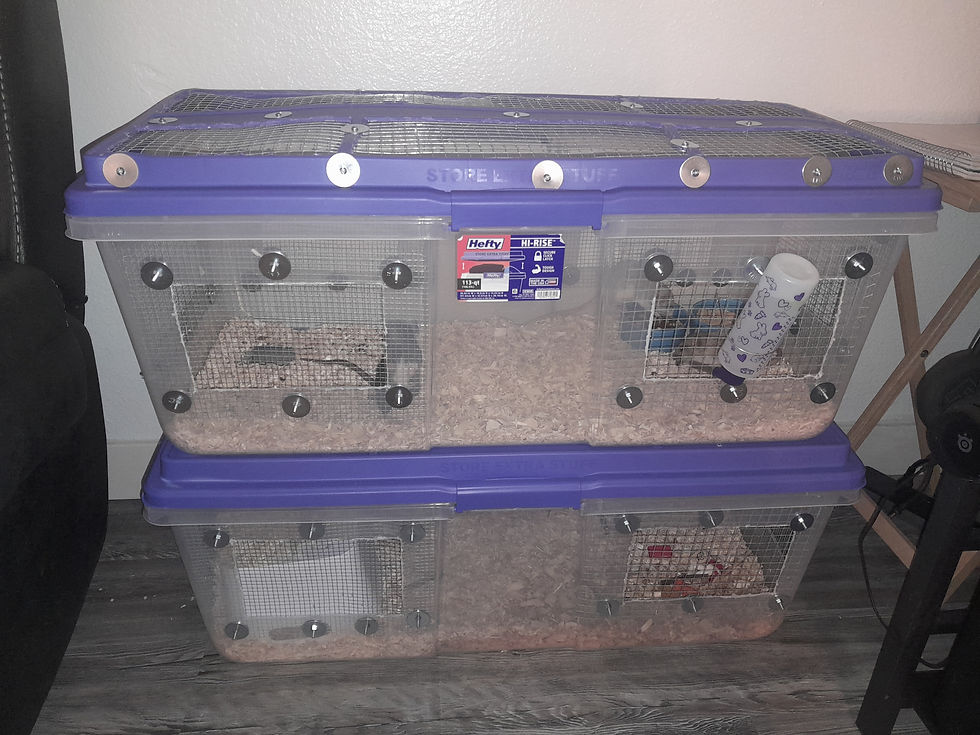How to Determine the Ideal Cage Size for Keeping Multiple Pet Rats Happy and Healthy
- StormHaven Rattery

- Jun 10
- 3 min read
Updated: Aug 29

Caring for pet rats is a rewarding experience, but it comes with responsibilities. Among the most crucial is ensuring they have enough space to thrive. Rats are social and active creatures that need room to explore and play. In this guide, we’ll explore how to choose the ideal cage size for a happy and healthy rat environment.
Understanding Rat Behavior and Needs
Rats are highly social animals that flourish in groups. They love to climb, explore, and interact with each other. Understanding these behaviors can help you determine the right cage size.
In the wild, rats can roam over a mile daily. When kept as pets, they still have that urge to explore. A cage that is too small can lead to stress, aggression, and health problems. For example, studies show that confined rats display increased anxiety-related behaviors. Providing enough space is essential for their natural behaviors and overall happiness.
Minimum Cage Size Recommendations
For multiple pet rats, the recommended minimum is 2 cubic feet of space per rat. If you have two rats, aim for a cage with at least 4 cubic feet.
A tall cage with multiple levels can maximize space. Rats enjoy climbing, and a vertical design allows for more enrichment opportunities. Remember, a larger cage promotes physical activity and mental stimulation, making a significant difference in their welfare.
Specific Cage Dimensions
While cubic footage is a helpful guideline, specific dimensions matter too. A well-designed cage should be:
At least 24 inches wide
24 inches deep
48 inches tall
This setup provides ample room for rats to run, jump, and climb. Cages designed for ferrets or specialized rat habitats offer good height and depth. Avoid narrow or cramped cages, as they limit movement and can affect your rats’ well-being.
Importance of Enrichment and Sustainability
A spacious cage is just one part of the equation. Enhancing the environment is equally important. Consider adding:
Shelves
Ropes
Tunnels
These additions encourage climbing and exploring. Chew toys and hiding spots also stimulate their minds. A well-furnished cage allows smaller spaces to feel larger. For instance, studies indicate that enriched environments can reduce stress behaviors in rats by up to 30%.
Assessing the Number of Rats
The number of rats influences your cage size. Each additional rat warrants more space. If you plan to keep three or four rats, invest in a larger cage to ensure comfort and interaction.
Rats are known for their social nature, so proper space is essential for a happy life. A cage that accommodates their social needs can greatly improve their quality of life. For example, keeping sufficient space can lead to a 25% increase in playtime and interactions among rats.
Cleaning and Maintenance Considerations
A clean living space is vital for your rats' health. Larger cages may require more cleaning but provide a more hygienic environment.
Choose a cage design with features that make maintenance easier, like removable trays or platforms. This allows for regular cleaning while ensuring your rats have a healthy living area. Despite the size, daily spot cleaning is essential to manage odors and waste.
Making the Right Choice for Your Furry Friends
Choosing the right cage size for your pet rats involves understanding their needs and behaviors. An appropriate cage should provide sufficient space, vertical dimensions, and opportunities for enrichment.
Investing in a well-designed cage can significantly enhance your pet rats' quality of life. A spacious, engaging habitat promotes physical activity and social interaction, leading to happier and healthier rats. By providing this essential environment, you are ensuring that your furry companions have a fulfilling and active lifestyle.

Comments